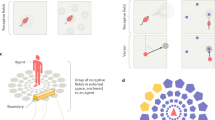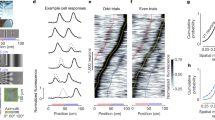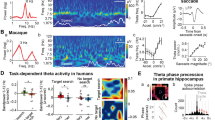Abstract
Multiple sensory-motor maps located in the brainstem and the cortex are involved in spatial orientation. Guiding movements of eyes, head, neck and arms they provide an approximately linear relation between target distance and motor response. This involves especially the superior colliculus in the brainstem and the parietal cortex. There, the natural frame of reference follows from the retinal representation of the environment. A model of navigation is presented that is based on the modulation of activity in those sensory-motor maps. The actual mechanism chosen was gain-field modulation, a process of multimodal integration that has been demonstrated in the parietal cortex and superior colliculus, and was implemented as attraction to visual cues (colour). Dependent on the metric of the sensory-motor map, the relative attraction to these cues implemented as gain field modulation and their position define a fixed point attractor on the plane for locomotive behaviour. The actual implementation used Kohonen-networks in a variant of reinforcement learning that are well suited to generate such topographically organized sensory-motor maps with roughly linear visuo-motor response characteristics. In the following, it was investigated how such an implicit coding of target positions by gain-field parameters might be represented in the hippocampus formation and under what conditions a direction-invariant space representation can arise from such retinotopic representations of multiple cues. Information about the orientation in the plane—as could be provided by head direction cells—appeared to be necessary for unambiguous space representation in our model in agreement with physiological experiments. With this information, Gauss-shaped “place-cells” could be generated, however, the representation of the spatial environment was repetitive and clustered and single cells were always tuned to the gain-field parameters as well
Similar content being viewed by others
References
Andersen RA, Mountcastle VB (1983) The influence of the angle of gaze upon the excitability of the light-sensitive neurons of the posterior parietal cortex. J Neurosci 3(3):532–548
Andersen RA (1997) Multimodal integration for the representation of space in the posterior parietal cortex. Philos Trans R Soc Lond B Biol Sci 352(1360):1421–1428
Batista AP, Buneo CA, Snyder LH, Andersen RA (1999) Reach plans in eye-centered coordinates. Science 285:257–260
Bao S, Chan VT, Merzenich MM (2001) Cortical remodeling induced by activity of ventral tegmental dopamine neurons. Nature 412:79–83
Burgess N, Donnett JG, Jeffery KH, O’Keefe J (1997) Robotic and neuronal simulation of the hippocampus and rat navigation. Philos Trans R Soc London B Biol Sci 352:1535–1543
Calton JL, Stackman RW, Goodridge JP, Archey WB, Dudschenko, Taube JS (2003) Hippocampal place cell instability after lesions of the head direction cell network. J Neurosci 23:9719–9731
Chialvo DR, Bak P (1999) Learning from mistakes. Neuroscience 90(4):1137–1148
Cooper BG, Miya DY, Mizumori SJ (1998) Superior colliculus and active navigation: a role of visual and non visual cues in controlling cellular representation of space. Hippocampus 89:340–372
Clower DM, Hoffman JM, Votaw JR, Faber TL, Woods RP, Alexander GE (1996) Role of posterior parietal cortex in the recalibration of visually guided reaching. Nature 383:618–621
Deadwyler SA, Hampson RE (1999) Anatomic model of hippocampal encoding of spatial information. Hippocampus 9(4):397–412
Du Lac S, Knudsen EI (1990) Neural maps of head movement vector and speed in the optic tectum of the barn owl. J Neurophysiol 63:131–146
Durstewitz D, Seamans JK, Sejnowski TJ (2000) Neurocomputational models of working memory. Nat Neurosci 3(Suppl):1184–1191
Fenton AA, Muller RU (1998) Place cell discharge is extremely variable during individual passes of the rat through the firing field. PNAS 95(6):3182–3187
Foster DJ, Morris RG, Dayan P (2000) A model of hippocampally dependent navigation, using the temporal difference learning rule. Hippocampus 10(1):1–16
Frank LM, Brown EN, Wilson M (2000) Trajectory encoding in the hippocampus and entorhinal cortex. Neuron 27(1):169–178
Frey U, Morris RG (1997) Synaptic tagging and long-term potentiation. Nature 385:533–536
Groh JM, Trause AS, Underhill AM, Clark KR, Inati S (2001) Eye position influences auditory responses in primate inferior colliculus. Neuron 29(2):509–518
Groh JM (2001) Converting neural signals from place codes to rate codes. Biol Cybern 85(3):159–165
Hampson RE, Simeral JD, Deadwyler SA (2002) “Keeping on track”: firing of hippocampal neurons during delayed-nonmatch to sample performance. J Neurosci 22:RC198
Hirase H, Leinekugel X, Csicsvari J, Czurko A, Buzsaki G (2001) Behaviour-dependent states of the hippocampal network affect functional clustering of neurons. J Neurosci 21(10):RC145
Hartline PH, Vimal RL, King AJ, Kurylo DD, Northmore DP (1995) Effects of eye position on auditory localization and neural representation of space in superior colliculus of cats. Exp Brain Res 104(3):402–408
Hoffsummer F, Wolf F, Geisel T, Löwel S, Schmidt K (1995) Sequential bifurcation and dynamic rearrangement of columnar patterns during cortical development. In: Bower JM (eds). Computational neuroscience, trends in research 1995. Academic Press, New York
Hopfield JJ (1982) Neural networks and physical systems with emergent collective computational capabilities. PNAS 79:3088–3092
Inoue K, Kawashima R, Satoh K, Kinmura S, Sugiura M, Goto R, Ito M, Fukuda H (2000) A Pet study of visuomotor learning under optical rotation. Neuroimage 11:505–516
Jay MF, Sparks DL (1987) Sensorimotor integration in the primate superior colliculus. II. Coordinates of auditory signals. J Neurophysiol 57(1):35–55
Knudsen EI (1982) Auditory and visual maps of space in the optic tectum of the owl. J Neurosci 2:1177–1194
Knudsen EI (2002) Instructed learning in the auditory localization pathway of the barn owl. Nature 417:322–328
Kohonen T (1988) Self-organization and associative memory. Springer, Berlin Heidelberg New York
Martin PD, Berthoz A (2002) Development of spatial firing in the hippocampus of young rats. Hippocampus 12:465–480
McAdams GJ, Maunsell JH (1999) Effects of attention on orientation-tuning functions of single neurons in macaque cortical area V4. J Neurosci 19(1):431–441
McAdams CJ, Maunsell JH (2000) Attention to both space and feature modulates responses in macaque area V4. J Neurophys 83(3):1751–1755
McNaughton BL, Barnes CA, O’Keefe J (1983) The contribution of position, direction, and velocity to single unit activity in the hippocampus of freely moving rats. Exp Brain Res 52:41–49
Muller RU, Kubie JL (1987) The effects of changes in the environment on the spatial firing of hippocampal complex-spike cells. J Neurosci 7(7):1951–1968
Muller RU, Bostock E, Taube JS, Kubie JL (1994) On the directional firing properties of hippocampal place cells. J Neurosci 14:7235–7251
O’Doherty J, Deichmann R, Critchley HD, Dolan RJ (2002) Neural responses during anticipation of primary taste reward. Neuron 33(5):668–671
O’Keefe J, Nadel L (1978) The hippocampus as a cognitive map. Oxford University Press, New York
Peck CK, Baro JA, Warder SM (1995) Effects of eye position on saccadic eye movements and on the neuronal responses to auditory and visual stimuli in cat superior colliculus. Exp Brain Res 103(2):227–242
Recce M, Harris KD (1996) Memory for places: a navigational model support of Marr’s theory of hippocampal function. Hippocampus 6:735–748
Redish AD, Battaglia FP, Chawla MK, Ekstrom AD, Gerrard JL, Lipa P, Rosenzweig ES, Worley PF, Guzowski JF, McNaughton BL, Barnes CA (2001) Independence of firing correlates of anatomically proximate hippocampal pyramidal cells. J Neurosci 21(5):RC134
Ritter H, Martinetz T, Schulten K (1992) Neural computation and self-organizing maps. AddisonWesley, Reading
Rolls ET, Burton MJ, Mora F (1980) Neurophysiological analysis of brain-stimulation reward in the monkey. Brain Res 194(2):339–357
Rolls ET (1999) Spatial view cells and the representation of place in the primate hippocampus. Hippocampus 9:467–480
Salinas E, Abbott LF (1997) Invariant visual responses from attentional gain fields. J Neurophysiol 77(6):3267–3272
Salinas E, Sejnowski TJ (2001) Gain modulation in the central nervous system: where behavior, neurophysiology, and computation meet. Neuroscientist 7(5):430–440
Save E, Poucet B (2000) Involvement of the hippocampus and associative parietal cortex in the use of proximal and distal landmarks for navigation. Behav Brain Res 109(2):195–206
Sharp PE, Blair HT, Brown M (1996) Neural network modeling of the hippocampal formation spatial signals and their possible role navigation in navigation: a modular approach. Hippocampus 6:720–734
Stricanne B, Andersen RA, Mazzoni P (1996) Eye-centered, head-centered, and intermediate coding of remembered sound locations in area LIP. J Neurophysiol 76(3):2071–2076
Suri RE, Schultz W (1999) A neural network model with dopamine-like reinforcement signal that learns a spatial delayed response task. Neuroscience 91(3):871–890
van Hoesen (1982) The parahyppocampal gyrus. New observations regarding its cortical connections in the monkey. Trends Neurosci 5:345–350
Waelti P, Dickinson A, Schultz W (2001) Dopamine responses comply with basic assumptions of formal learning theory. Nature 412(6842):43–48
Wiener SI, Paul CA, Eichenbaum H (1989) Spatial and behavioral correlates of hippocampal neuronal activity. J Neurosci 9:2737–2763
Author information
Authors and Affiliations
Corresponding author
Rights and permissions
About this article
Cite this article
Kaske, A., Winber, G. & Cöster, J. Motor-maps, navigation and implicit space representation in the hippocampus. Biol Cybern 94, 46–57 (2006). https://doi.org/10.1007/s00422-005-0021-0
Received:
Accepted:
Published:
Issue Date:
DOI: https://doi.org/10.1007/s00422-005-0021-0




